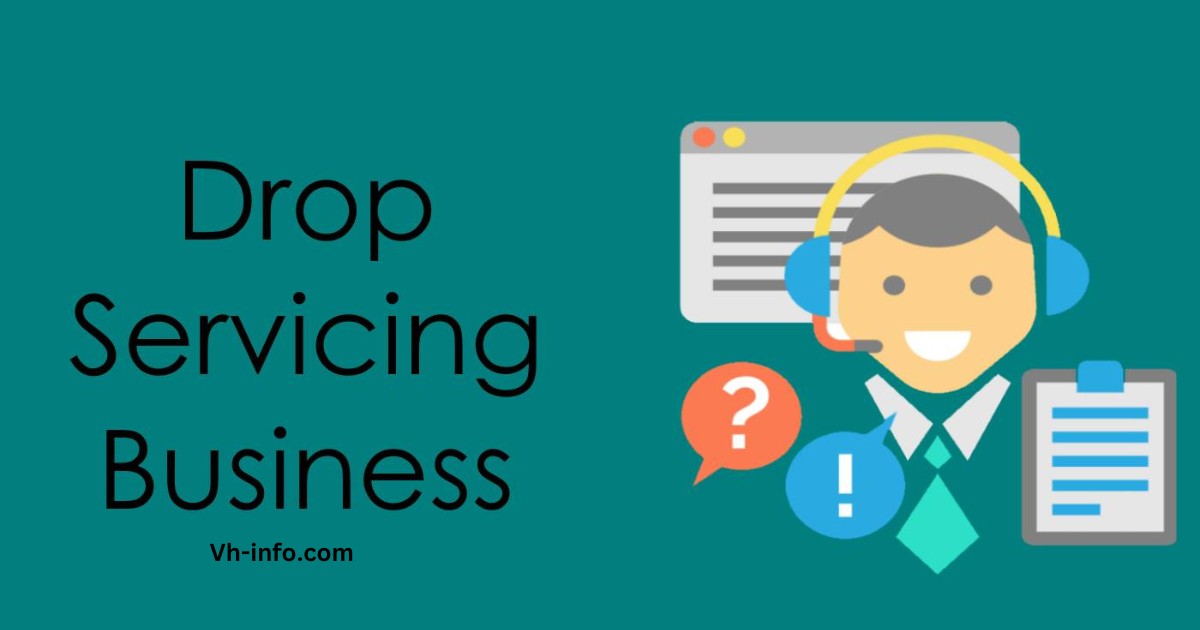Hey there! Ready to explore a cool way to make money outside the usual 9-5 routine?
Let’s talk about drop servicing. Imagine being the link between folks needing services and those skilled at providing them.
You offer services to clients but hire experts to do the job at great rates. This means you can give top-notch services without doing the work yourself.
In our blog, we’ll dive into drop servicing: how it works, its perks, how to kickstart your own, success stories, costs, services you can offer, and more! Whether you’re keen on starting a business or just curious, keep reading!
By the way, have you checked out vh-info? They’re a savvy link-building agency for SaaS companies, and they can help you kickstart your drop-servicing journey too!
What is Drop Servicing?
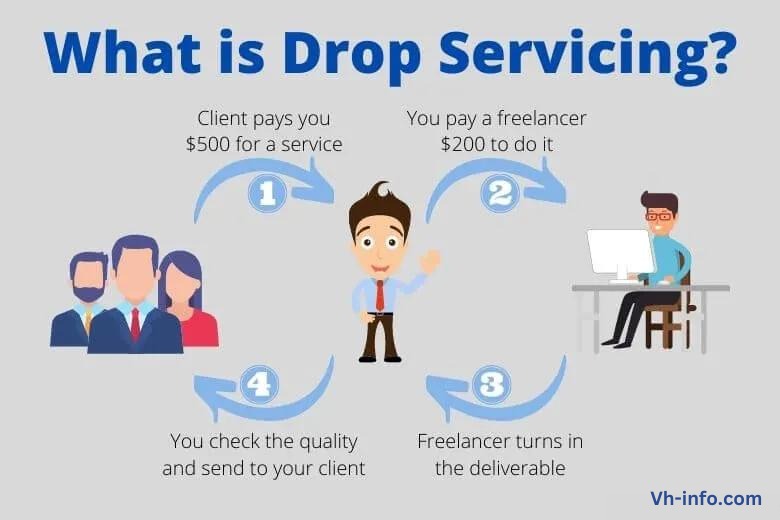
Drop servicing is a business model where you offer services to clients without actually providing the services yourself. Instead, you outsource the services to freelancers and take a percentage of what the clients pay.
So essentially you find clients who need a service, connect them to freelancers who can provide it, handle payments and communication, but don’t do the work. It allows you to sell services you can’t do yourself by leveraging freelancers. It’s a way to make money with minimal work through outsourcing.
How does Drop Servicing Work?

Drop servicing is a business model that allows entrepreneurs to provide services to clients without actually owning a service-based business themselves.
Here are the key aspects of how drop servicing works:
- The drop servicer acts as a middleman between clients who need a particular service, and freelancers or companies who can provide that service. For example, a client may need web development services.
- The drop servicer does not actually provide the services themselves. Instead, they find and vet freelancers or agencies that can provide the specific services the client requests. The freelancers or agencies provide the actual services.
- The client pays the drop servicer for arranging and coordinating the services. The drop servicer then pays the freelancer or agency for actually doing the work, typically keeping some percentage as profit.
- Common services offered through drop servicing include graphic design, web development, digital marketing, SEO, writing, business consulting and more. However, almost any service business can potentially work with this model.
- The value that drop servicers provide is by finding and vetting quality freelancers, managing the process and communication between clients and freelancers, and handling client acquisition – allowing clients to get services and freelancers to get work more easily.
So, drop servicing allows entrepreneurs to run a service business without actually providing the services themselves – they play a coordinating role between client needs and external service providers. It provides more flexibility than owning a full agency.
Benefits Of Drop Servicing
Here are 5 key benefits of drop servicing:
- Low Startup Costs – You don’t need much investment, just a laptop and internet to get started. Leverage freelancers for minimal upfront costs.
- Easy to Scale – You can take on more clients without hiring more staff by leveraging more freelancers. Grow your business faster.
- No Expertise Needed – You don’t need to be an expert in the services yourself. Freelancers handle delivering the actual services.
- Flexible – You can work when you want from anywhere with an internet connection. It’s a location-independent business.
- Higher Profit Margins – You keep the difference between what clients pay and the lower rates paid to freelancers. This model allows healthy margins.
Challenges And Limitations Of Drop Servicing
Here are 5 main challenges and limitations of drop servicing:
- Finding Good Freelancers – It can be difficult to find skilled and reliable freelancers who provide consistent quality work. Extensive vetting is required.
- Managing Communication – As the middleman between clients and freelancers, managing communication and expectations on both sides can be tricky.
- Tight Profit Margins – After paying freelancers, profit margins can sometimes become too tight to justify the effort. Pricing has to be set appropriately.
- Lack of Control – You have little control over the actual delivery of the services compared to other business models. Quality control is imperative.
- Building Trust and Reputation – As a new business, establishing a professional reputation, reliability and trust with both clients and freelancers poses challenges initially.
How to Start a Drop Servicing Business?
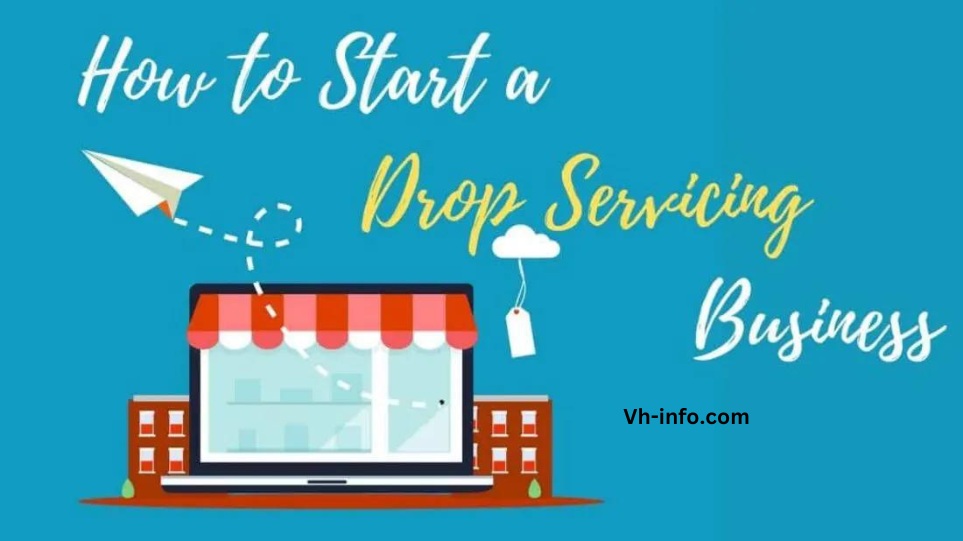
Starting a drop-servicing business isn’t super complicated. It doesn’t need a lot of money or a big investment. You can begin your own drop servicing business by getting freelancers or virtual helpers to manage the work while you concentrate on advertising and making sales.
But before anything else, you have to pick what area you want to focus on.
Choose your Niche
Picking what you specialize in is a big deal when you start a drop servicing business.
It’s tricky because you have to find out who might want to buy what you offer. To do this, you can use tools like Google Trends and Google Keyword Planner for market research. These tools help you see what services potential customers look for the most. After making a list, you can check places like Reddit and Quora to see if people are interested in those specific areas.
Let’s start with the service your business will offer. Remember, there are many options available. Your imagination is key here!
If you’re not sure which drop servicing area to pick, think about these things:
- Do I know a lot about any particular idea already?
- If not, which idea looks doable or interesting to learn about?
- Which ideas seem easy to start and do?
- Which ideas do people really need or want?
- Which ideas could make the most money for my business?
Choosing a niche can be tricky. Think about what matters most to you and build your business based on that.
Find and Train your Team of Service Providers
Picking your team is a crucial step in your drop servicing business. They’re the heart of your business, so choose wisely.
Here’s a checklist for when you’re picking people for your team:
- Do they know a lot about the service you want? Ask for examples.
- How much training will they need to meet your standards?
- Will they finish their work on time and be dependable?
- Are they good at communicating and working together?
- Do they live in a different time zone? Will that cause problems?
You can find team members on sites like Fiverr, Upwork, and others. Once you find some good options, give them a small test project to see how well they do.
Build your Brand and Bring it to Life
Once you’ve got your plan and a great team, it’s time to set up your company! If you’re looking to find clients online, having a good online presence is super important.
Your website is the most crucial part. Also, think about making social media profiles.
There are lots of tools to build websites like Shopify, Wix, WordPress, and Squarespace. Many let you try for free before you decide.
Make sure your website and other things related to your brand have:
- A unique logo that shows what your brand is about
- Info about your brand, why you do what you do, and what makes you special
- Details about your services and what clients can expect (you can share prices or talk about them during sales)
- If you’re selling stuff online, put your prices and choose a website tool that lets you take payments online
- If you’re aiming to build a website for your no-code app on all platforms without diving into complex coding, consider seeking assistance from Squarespace SEO experts to optimize your online presence for maximum visibility and engagement.
Attract Customers with Marketing
Marketing is super important for any business. It’s no good having a great brand and website if no one sees it, right?
There are many ways to make your business known, get new clients, and keep the ones you have.
Here are a few:
- Referral marketing. It’s a way to get more customers without spending a lot. You can start a program that rewards current customers for bringing in new ones.
- Content marketing. This means using different kinds of content like blogs, videos, emails, pictures, books, and even podcasts. It helps teach, entertain, and make more people aware of your brand.
- Social media marketing. If your customers are on social media, you can make special plans to talk to them there. Just find out where they are and make content for those places.
Make your First Sale … and keep going!
They say your first sale is a special moment. Sometimes it happens quickly, other times it’s tough. But the important thing is to keep going and not give up.
When you talk to more potential clients, you’ll learn what works and what doesn’t.
Listen carefully to what these potential clients are saying. Is your price too high? Are you forgetting something important? Maybe your competition is doing something that you should also think about doing.
Drop Servicing Business Examples
- Website Building – Find clients who need a website. Outsource their website building projects to freelance web developers at a lower price. Handle client relations yourself.
- Graphic Design – Get clients who need graphics work like logos, brochures etc. Pass on the work to graphic designers at cheaper rates. Manage project deliverables. Or you can create by yourself by using a logo maker, or brochure maker app.
- Digital Marketing – Offer search engine optimization, social media marketing, email marketing to local businesses. Hire online marketing freelancers to actually execute campaigns at affordable costs.
- Business Consulting – Provide consulting to startups or small businesses on their operations, processes etc. Leverage freelance business consultants to advise them over calls/emails.
- Transcription Services – Provide transcription services for videos, podcasts, interviews etc. Hire freelancers to transcribe the audio/video content.
- Animation Video Creation – Offer animated explainer video services for businesses. Outsource video creation to animation specialists and designers.
- Bookkeeping – Offer bookkeeping and accounting services to small businesses. Leverage bookkeepers to handle tasks like reconciliations, financial reporting.
- Tech Support – Provide ongoing tech/IT support for consumers and small businesses. Use freelance computer technicians to troubleshoot.
- Logo Animation – Sell animated logo reveal services for brands. Pass these video projects to animation studios.
- Product Listing – Offer product listing optimization for eCommerce stores. Hire freelancers to create SEO-optimized listings.
How much does it cost to start a drop servicing business?
The great thing about drop servicing is that you can start with minimal capital and a low budget.
Here is a quick breakdown of the approximate costs to get a basic drop servicing business up and running:
- Website & Domain – $100-300 depending on options This would cover building a simple informational website to promote your services and allow prospects to contact you.
- Branding – $50-200 for a logo and branding Even a basic logo design and color palette helps lend legitimacy early on.
- Admin Tools – $50-100/month Includes email service, productivity software, CRM, project management tools etc. Automation helps.
- Marketing – $100-300 initially Could include things like business cards, listings, online directories submission to get the word out.
Total: Approximately $500-1200 to cover the basics
The largest recurring costs then become any paid ads for client acquisition. But otherwise, it’s possible to start a basic drop servicing operation for under $1500 if you manage costs diligently. Let the profits help fuel further growth.
So, extremely lean compared to other small business models that require office space, inventory, equipment etc. The outsourced nature of drop servicing keeps overheads very low in these early stages.
What Products or Services Can You Drop Service?
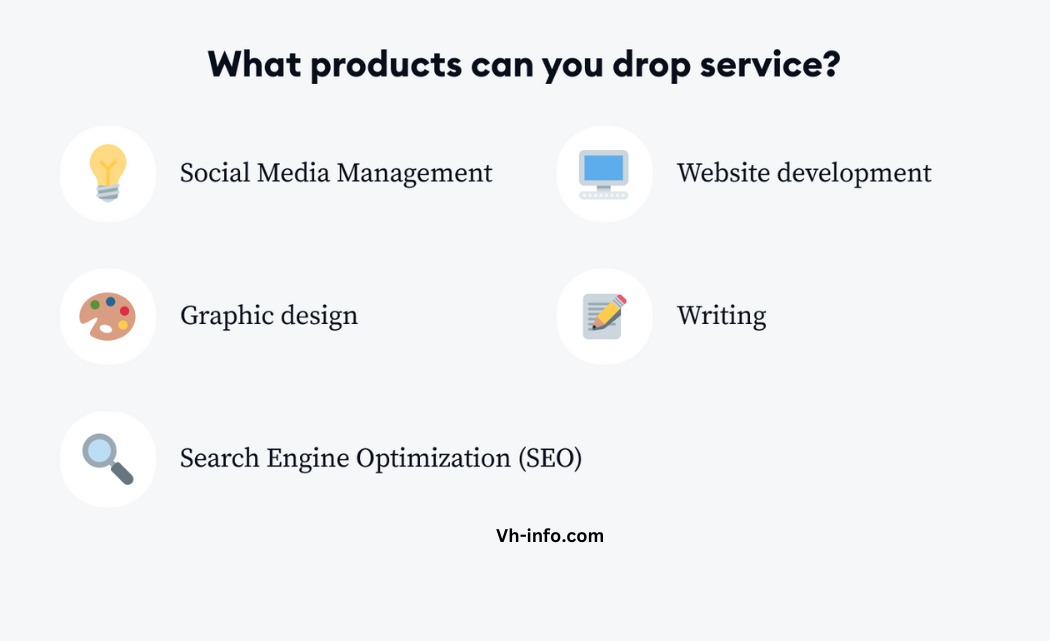
The various products or services you can offer in a drop servicing business are as follows:
- Design: Every business needs designs. This could be for things like making their brand look good, packaging products, or advertising. Lots of businesses know that hiring freelancers or agencies for designs can cost a lot of money. But with drop servicing, businesses might save more money by asking other companies to do their graphic design work for them.
- Writing: In the online world, people believe that content is really important. This is still true today. Every business that wants to be noticed online needs people who write well, like copywriters and content writers. It’s something to think about in drop servicing. You can hire different freelance writers to do the writing work for you. Also, there are services specifically for writing content that you can try. These services can help with different types of writing, like blogs, and writing for websites, ads, and emails. A paraphrase tool can also assist in rephrasing sentences and paragraphs.
- Video Creation and Production: This has three parts. First, if a YouTuber asks you for help with making or editing videos, they’ll need someone like an editor or producer. Second, some businesses might need videos for their brand or products. Lastly, businesses might want videos for marketing their products or services.
- Data Entry and Analytics: Some businesses like real estate, shipping, and banking need assistance with entering data. If your clients work in industries that rely a lot on entering data, your drop servicing business can make good money. The people who are best at this job are either beginners or those who work part-time entering data. Besides data entry, your clients might also want data analysis. For this, they’ll need an experienced freelancer in that field. Moreover, banks and other financial institutions should adopt IDP in fintech in fintech to streamline operations and manage documents efficiently.
- Marketing: Another area you can think about in drop servicing is marketing. Some businesses think that hiring marketing agencies costs a lot. Businesses won’t search for marketers directly on freelance platforms if they choose drop servicing. You might need to find freelancers who are experts in different types of marketing, like social media, inbound, email, and content.
- SEO: Lots of businesses want to be at the top of search engines, so SEO (search engine optimization) is really important. Many freelancers know a lot about SEO and can help different clients. By adding SEO experts to your drop servicing business, you can make your online presence stronger and make more people know about your brand.
- Advertising: Another service you can offer is advertising. There are many parts to it like making ads, videos, social media ads, and ads for publications. Doing this needs special skills because they might work on writing, design, and making videos all together.
- Web Development: If a business wants to be seen online, it needs a drop servicing website. Site builders can make it quickly, but web developers help keep the website working well. You can find skilled web developers like front-end, back-end, and full-stack developers on freelance websites for your drop servicing business.
- Programming: Another thing you might think about for your drop servicing business is programming. Lots of brands want special apps for their stuff, like online stores or shipping services. Programmers are the ones who can make these apps, so you might want to have them on your team too.
- Social Media: Businesses often hire a drop servicing reseller for social media help. Some businesses need someone to manage their social media accounts. They might want freelancers who are good at managing communities and designing posts, especially if they prefer just one person to handle their social media.
- Translation: Big companies that operate worldwide might need help translating things they use internally or for their brand. Sometimes a business wants to start selling in other countries. If you have a drop servicing business, you can easily find freelancers who specialize in translation. They can help these businesses with their needs.
- Audio and Music: This area might seem not so popular, but people making podcasts and videos need help with sounds and music. For instance, a business might want someone to speak over their videos for marketing. Or they might need special music or tracks for their brand.
- Transcription: People who make podcasts or videos might need help writing down everything that’s said in them. This is called transcription. Sometimes they’re too busy to listen to their episodes or videos and write it all down themselves. If you offer this service, lots of people might want to hire you for it.
- Accounting: Small businesses sometimes need help managing their money and keeping track of their sales and expenses. They can ask a drop servicing reseller for help with accounting. This is important for them because it gives them time to focus on growing their business. Offering accounting services could be a good idea for your drop servicing business.
- Interior Design: Shops that want to open more stores in different places might need an interior designer’s help. But if they don’t have enough money to hire an experienced interior designer, they might ask your drop service business for help. Even though they can’t be there in person to design the store, they can share ideas for the design and give pictures and plans to start the work.
- Animation: Making animations is a part of creating videos. But it’s not just for videos – animations can also be used in making pictures and designing characters. Also, businesses making gaming apps and online games will need people who can create animations. If you’re working with different clients who have these needs, you might need different animators to help you out.
How to get Clients for Drop Servicing?

Here’s on how to get clients for your drop servicing business:
- Research Market Demand: Look into what services people want the most and are willing to pay for. Websites like freelance job boards and tools like Google Trends can help you identify trending services.
- Promote Your Business: Spread the word about your drop servicing business. Use social media, create a website, or advertise on platforms where potential clients hang out. The goal is to make them aware of your services.
- Send Proposals: Reach out to suppliers and let clients know upfront about cost-saving options like supplier location. Being transparent can help attract more customers.
- Utilize LinkedIn: Connect with potential partners and leverage word-of-mouth marketing through referrals. Networking on LinkedIn can help you find clients and build partnerships.
- Try Facebook Ads: Facebook advertising can be a potent tool for attracting clients to your drop servicing business. Create targeted ads to reach your desired audience.
Other strategies that can help you get clients for drop servicing include:
- Undercutting Competitors: Offering competitive pricing or additional value can make your services more appealing.
- Using GetResponse: Utilize email marketing tools like GetResponse to reach out to potential clients and maintain communication.
- SEO Strategies: Optimize your website and content for search engines to improve visibility and attract organic traffic.
- Focus on Evergreen Services: Offer services that are always in demand, like website development, ensuring a consistent flow of potential clients.
By combining these strategies and adapting them to your business, you can effectively attract clients for your drop servicing venture. Remember, building a strong reputation and delivering quality service are key to retaining clients and growing your business in the long run.
Where can you promote Drop Servicing?

You can tell people about your business on different places online, like:
- Social media sites (like Facebook, Instagram, Twitter, LinkedIn)
- Freelance websites (like Upwork, Fiverr, Freelancer)
- Online stores (like Amazon, Etsy, eBay)
- Business listings (like Yelp, Google My Business)
- Your own website or blog
Drop Servicing Blueprint
Here are simple steps to start this business:
- Pick what you’ll specialize in.
- Find people who can do the work.
- Make a website or page to get clients.
- Decide how much you’ll charge.
- Tell people about your services.
- Get orders and talk to the people doing the work.
- Give the finished work to your clients.
The Difference Between Drop Servicing and Dropshipping

Here is the key differences between dropshipping and drop servicing:
| Basis for Comparison | Dropshipping | Drop Servicing |
|---|---|---|
| What is sold | Physical products | Services |
| Role of middleman | Sells products, handles marketing/sales | Sells and delivers services, handles marketing/sales |
| Inventory | Supplier holds inventory | No inventory involved |
| Logistics | Handled by supplier | Handled by service provider |
| Effort required | Lower, focus on sales/marketing | Higher, consult with service providers |
| Profit margin | Retail price – wholesale price | Retail price – wholesale service rate |
| Risks | Inventory issues, shipping delays | Quality control, dependability of providers |
| Examples | Selling supplements, apparel, electronics | Web design, writing services, marketing services |
FAQ’s:
Is Drop Servicing Legal?
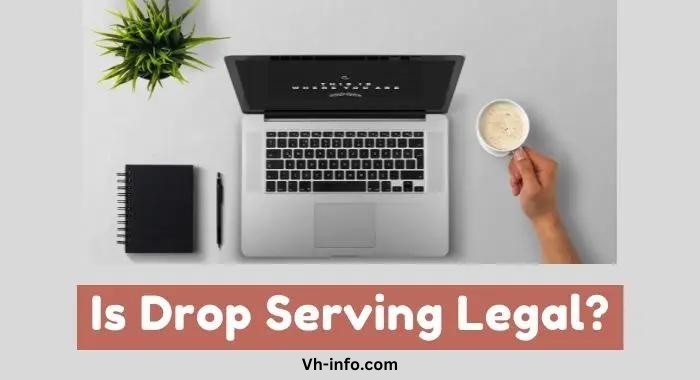
Yes, drop servicing is completely legal.
As long as you run your business honestly and transparently, there are no legal issues with this model. You provide real services to clients by outsourcing the work to freelancers that you pay fairly for their work. There is no fraud or deception involved when done right.
You do still need to follow all standard business compliance rules and tax laws like any other company. But the core concept of acting as a middleman, finding clients, managing the services, without actually doing the work yourself is not illegal at all.
As long as both your customers and freelancers clearly understand your value proposition and terms, are willing participants, and services are delivered satisfactorily, drop servicing operates well within legal bounds. You provide legitimate value to both sides.
Is Drop Servicing Profitable?
Yes, drop servicing can certainly be a very profitable business model.
By acting as the middleman between clients and freelance talent, you get to charge a rate to customers that covers both the cost of freelancer fees plus your own profit margin. So after paying out freelancers at lower price points, you pocket the difference.
Margins in drop servicing are often healthy since freelance services come at affordable costs compared to final prices charged to customers.
And because you can scale drop servicing through technology without too many overheads, higher volumes bring the ability to compound profits.
However, just like any business, appropriate pricing strategy, cost control and customer service is key to long term returns. Offshore customer service can play a crucial role in maintaining cost control while delivering excellent customer support. By outsourcing customer service operations to offshore teams, businesses can benefit from lower operational costs without compromising on service quality. This strategic approach allows companies to allocate resources efficiently, ensuring sustainable profitability and long-term success.
But executed well with some persistence, drop servicing provides the foundation and leverage needed for substantial profit generation over time through well-managed client projects. The outsourced nature of delivery keeps risk low too.
Is Drop Servicing The Same As Reselling?
No, drop servicing isn’t reselling. It’s more like a kind of trade where you buy something at a lower price and then sell it for a higher price. In this case, the price is decided by the partner who provides the service.
Can you start Drop Servicing with no Budget?
Yes, it is possible to launch a drop servicing business without any substantial startup capital through sweat equity and strict cost control initially.
By minimizing expenses, ensuring at least 50% client payment upfront, establishing clear written expectations, and leveraging free tools and unpaid reach opportunities in the beginning, you can start with essentially zero budget.
It will take hustle and financial discipline but the flexible outsourced structure of drop servicing enables ultra lean bootstrap starts.
What Skills do you need for Drop Servicing?
The most important skills for drop servicing are sales and client acquisition abilities, project and freelancer management competencies, and basic admin, finance and accounting knowledge.
As the middleman between customers and service fulfillment, you need marketing aptitude to locate clients, operational skills to oversee freelancers, and organizational skills to manage the business.
Technical expertise in the actual services isn’t as necessary since freelancers handle delivery. The core skills involve generating demand, managing outsourced capacity, and running the back-end logistics of the operation.
Can I make Good Money with a Drop Servicing Business?
Some folks may ask how much money you can make with drop servicing. It’s important to understand that while some drop servicing businesses can be profitable, you need to put in effort and work hard.
The service business isn’t a way to get rich quickly. But if you look online, you’ll see that drop shipping has been making good money for some time. It might be a good idea to start with a dropshipping business first to see how it goes.
Is Dropservicing easy?
Yes, drop servicing is easy and anyone with a computer and internet can do it. But before starting, you need to understand the market and how it all works.
Remember, it won’t happen quickly. Building a successful drop servicing business takes time. It won’t make big profits right away.
Conclusion
In conclusion, drop servicing is a lucrative business model that allows you to leverage the skills and expertise of others to provide valuable services to clients.
By following the step-by-step guide outlined in this blog, you can start your own drop servicing business and achieve success.
Remember to choose a niche, find and train your team of service providers, build your brand, attract customers through marketing, and make your first sale.
Keep in mind that drop servicing comes with its own set of challenges and limitations, but with determination and strategic planning, you can overcome them.
Whether you’re interested in design, writing, video production, or any other service, there are endless opportunities to offer and promote your drop servicing business.
So, take action and embark on your entrepreneurial journey today!

